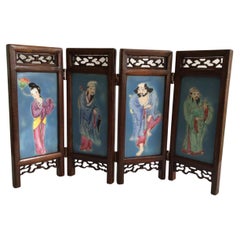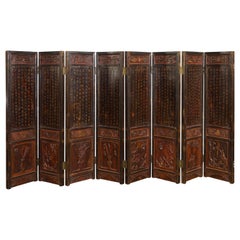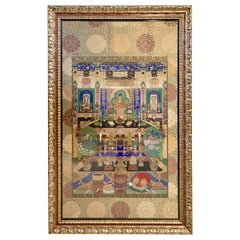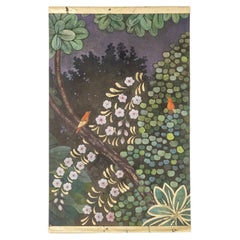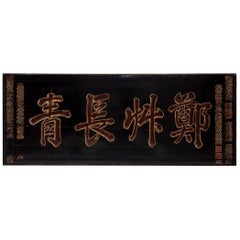Wood Paintings and Screens
1960s Vintage Wood Paintings and Screens
Porcelain, Wood
Mid-19th Century Chinese Chinese Export Antique Wood Paintings and Screens
Giltwood, Paint, Paper
20th Century Chinese Wood Paintings and Screens
Wood
Mid-19th Century Japanese Meiji Antique Wood Paintings and Screens
Brocade, Silk, Acrylic, Wood, Paint
20th Century French Wood Paintings and Screens
Gold Leaf
Mid-19th Century Chinese Qing Antique Wood Paintings and Screens
Elm
Early 20th Century Japanese Wood Paintings and Screens
Shell, Wood, Lacquer
20th Century Chinese Chinese Export Wood Paintings and Screens
Acrylic, Wood
19th Century Edo Antique Wood Paintings and Screens
Gold Leaf
Early 20th Century Japanese Taisho Wood Paintings and Screens
Silk, Paper, Wood
20th Century Neoclassical Wood Paintings and Screens
Wood, Canvas, Acrylic
20th Century Chinese Mid-Century Modern Wood Paintings and Screens
Glass, Wood, Paper
Mid-20th Century Japanese Showa Wood Paintings and Screens
Wood, Paper
20th Century Japanese Showa Wood Paintings and Screens
Wood, Paper
19th Century Japanese Meiji Antique Wood Paintings and Screens
Gold
20th Century Neoclassical Wood Paintings and Screens
Canvas, Acrylic, Wood
20th Century French Wood Paintings and Screens
Copper, Gold Leaf
Early 20th Century Japanese Meiji Wood Paintings and Screens
Silk, Wood, Paper
Mid-20th Century American Prairie School Wood Paintings and Screens
Canvas, Wood, Paint
20th Century Japanese Wood Paintings and Screens
Silk, Wood, Paper
Mid-19th Century Chinese Qing Antique Wood Paintings and Screens
Elm
Early 20th Century Wood Paintings and Screens
Fabric, Wood, Lacquer, Paper
20th Century French Wood Paintings and Screens
Canvas, Linen, Wood
Late 20th Century French Wood Paintings and Screens
Oak, Paper
Mid-20th Century Balinese Tribal Wood Paintings and Screens
Glass, Wood, Paper
20th Century Japanese Taisho Wood Paintings and Screens
Silver Leaf
20th Century French Wood Paintings and Screens
Copper, Gold Leaf
Early 19th Century Japanese Edo Antique Wood Paintings and Screens
Silk, Wood
Early 20th Century Chinese Qing Wood Paintings and Screens
Muslin, Elm
1920s Japanese Japonisme Vintage Wood Paintings and Screens
Silk, Wood
1980s Canadian Post-Modern Vintage Wood Paintings and Screens
Canvas, Acrylic, Wood
Early 20th Century Chinese Qing Wood Paintings and Screens
Wood, Linen
1960s Japanese Japonisme Vintage Wood Paintings and Screens
Silk, Wood
21st Century and Contemporary Chinese Wood Paintings and Screens
Wood, Paint
2010s American Wood Paintings and Screens
Glass, Wood, Hardwood, Paint, Paper
Mid-20th Century Chinese Wood Paintings and Screens
Canvas, Wood, Paint
Mid-20th Century Chinese Chinese Export Wood Paintings and Screens
Wood, Lacquer
1980s Japanese Japonisme Vintage Wood Paintings and Screens
Silk, Wood
Early 19th Century Japanese Edo Antique Wood Paintings and Screens
Silk, Wood
Mid-20th Century American Art Deco Wood Paintings and Screens
Wood
Early 20th Century Wood Paintings and Screens
Wood
Early 20th Century Asian Wood Paintings and Screens
Glass, Giltwood, Paper
1960s Japanese Japonisme Vintage Wood Paintings and Screens
Silk, Wood
1960s Tibetan Tibetan Vintage Wood Paintings and Screens
Bronze, Gold Leaf
Early 20th Century Japanese Meiji Wood Paintings and Screens
Silk, Wood, Paper
21st Century and Contemporary Wood Paintings and Screens
Aluminum
Early 20th Century Japanese Wood Paintings and Screens
Silk, Wood, Lacquer
1980s North American Vintage Wood Paintings and Screens
Masonite
19th Century Japanese Antique Wood Paintings and Screens
Silk, Wood, Paper
20th Century Japanese Wood Paintings and Screens
Metal
Mid-19th Century Japanese Edo Antique Wood Paintings and Screens
Silk, Wood, Paper
Early 20th Century Japanese Wood Paintings and Screens
Wood, Paper
Mid-20th Century Japanese Showa Wood Paintings and Screens
Wood, Paper
20th Century French Wood Paintings and Screens
Copper, Gold Leaf
2010s Virgin Islands Modern Wood Paintings and Screens
Sandstone
1960s British Other Vintage Wood Paintings and Screens
Canvas, Wood
21st Century and Contemporary American Wood Paintings and Screens
Walnut
1850s Japanese Japonisme Antique Wood Paintings and Screens
Wood
20th Century Japanese Wood Paintings and Screens
Aluminum
Early 20th Century Japanese Taisho Wood Paintings and Screens
Wood, Silk
